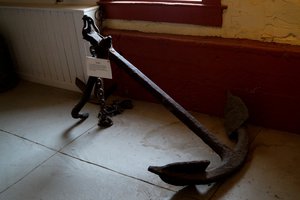Advertisement
Published: February 16th 2015

 STEAMBOAT ANCHOR
STEAMBOAT ANCHOR
Anchors were used to secure the riverboat to the river bottom in places where there were no docks. Anchors were also handy sometimes to help dislodge the riverboat from a grounding on a sandbar or a submerged tree trunk. Once in a while an anchor would be lost due to a broken rope. All manner of riverboat artifacts continue to be recovered during maintenance operations on the river system or after a flood. There are a couple of entities that have made Yuma prosper. One is agriculture and the other is the military. The success of agriculture is due to reclamation efforts that have brought water to the barren desert. The military influence on Yuma began in 1850 when Fort Yuma was established in response to the growing need for protection of fortune hunters bound for the California gold fields and to the massacre at Yuma Crossing of Captain John Joel Glanton and his merry band of killers and thieves. The War of Northern Aggression brought an increased military presence in 1862 and the military brought the need for riverboat commerce. The riverboats brought great prosperity into the Yuma area. The military presence faded away after the Apache wars ended but returned with gusto at the outbreak of WWII and have supported the community ever since. The Marine Corps Air Station and Yuma Proving Ground both grew out of the WWII facilities. The growth of riverboat commerce established by the army in 1864 and the growth of water availability through the past century intersect at the Quartermaster Depot. If Yuma has a birthplace it is there.
Colonel Carleton

 STEAMBOAT CAPSTAN
STEAMBOAT CAPSTAN
The capstan was a hand operated windlass attached by rope to the anchor. Long wooden poles were inserted into the square holes at the top of the capstan. When the anchor needed to be lifted deckhands would set the poles and then rotate the capstan by pushing the poles around in a circular direction. Fishing reels are smaller versions of capstans, marched his brigade of rag tag volunteers from California across Arizona to New Mexico in 1862. They were to assist in the expulsion of Confederate forces who were attempting to establish connection to the gold fields in both California and Colorado. The Confederate invasion of New Mexico sputtered out at Glorietta Pass before Carleton arrived but the California Volunteers remained to enforce federal control in the territories. Carleton was given command of the military district there and had a great deal of autonomy but was constantly in peril of losing control because supply lines were long and unreliable. After nearly starving to death for two years, the supply situation was improved by the construction of a quartermaster depot at Yuma. Needed supplies were brought by sea around the Baja Peninsula and up the Gulf of California and then transferred to river boats at the mouth of the Colorado River. The depot maintained a six month supply of all stores needed by military outposts in the southwest. After the War Between the States ended the country continued to grow and the depot grew with it until the eastbound railroad reached Tucson in 1881 and the quartermaster depot moved to Fort Lowell.

 STEERING WHEEL
STEERING WHEEL
The riverboats were maneuvered at a station called the helm. It was located in the pilot house and the wheel was connected through a series of cables and pulleys to the rudder. Hydraulic pressure against the rudder is what turned the boat. The wheel needed to be a large diameter because the rudders were heavy and those pressures were strong. At the peak of its operations 900 mules were stabled at the Yuma Quartermaster Depot. By 1891 the military presence in the southwest had declined and the Yuma depot was abandoned to the Signal Corps and Weather Service. The U S Reclamation Service moved onto the property during construction of Laguna Dam. Laguna was completed as a diversion facility in 1907 and riverboat traffic above Yuma ended. Reclamation projects have continued along the river ever since many of which were planned and administered from offices on the Quartermaster Depot grounds. The entire flow of the river is now diverted and completely over-budgeted. The final insult to the mighty Colorado was the desalination plant west of town. The salt plant was constructed to meet clean water treaty requirements with Mexico. It has never gone into service because flooding on the Gila River has scoured the salt out of the channel and the river now meets salinity requirements under the treaty. Most of the plant operators have retired by now or are nearing retirement soon. The salt plant has become an administrative center for maintenance of the river system. They used to have plant tours out there, but these days they have

 SALT PLANT
SALT PLANT
In response to the terrorist attacks on 9-11 the Bureau of Reclamation shut down all public tours to its dam facilities along the river. The Salt Plant was included in the shutdown although it is not a dam facility. It was a sad day when that happened. After all we would have already lost the War on Terror by the time the dam facilities were attacked. It seems silly to continue the shutdown but the managers prefer not to bothered with the pesky taxpaying citizenry. locked their gates under the guise of national security and are snoozing away the lazy afternoons in air conditioned comfort hoping to be left in peace by the pesky taxpaying citizenry. In its better days the Bureau of Reclamation did us all a great deal of good. Photos show remnants of the riverboat trade and the salt plant under lockdown since 9-11.
Advertisement
Tot: 0.276s; Tpl: 0.011s; cc: 9; qc: 49; dbt: 0.1586s; 1; m:domysql w:travelblog (10.17.0.13); sld: 1;
; mem: 1.1mb

 STEAMBOAT ANCHOR
STEAMBOAT ANCHOR
 STEAMBOAT CAPSTAN
STEAMBOAT CAPSTAN
 STEERING WHEEL
STEERING WHEEL
 SALT PLANT
SALT PLANT